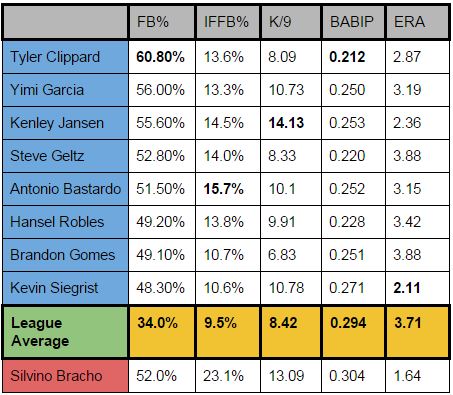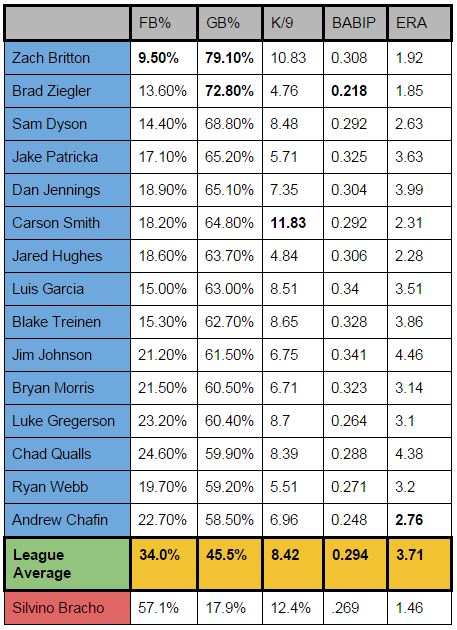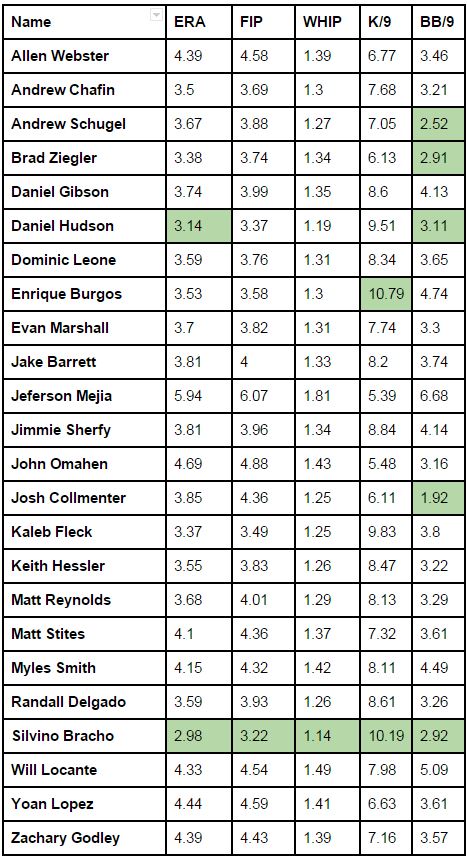The Silvino Linings Playbook
As volatile as relievers tend to be in 60-odd inning samples, it’s hard to get very excited about performance over shorter spans. If you want a great debut, you have no farther to look than record holder Brad Ziegler, who set a new standard with 39 consecutive scoreless innings to start his career. If you want greatness from a reliever within a short time, look to Addison Reed, who in 2013 — a few months before his acquisition from the White Sox — earned a save in a record-tying 6 consecutive team games, allowing a grand total of two hits and two walks in that span.
What does it look like, though, to be a dominant reliever in Arizona? Ziegler is unquestionably dominant, but it looks like that mold has been thrown away like a frisbee’d Ziegler Special (maybe we should put that mold back together). If relievers are very volatile, we’d expect bad things near-constantly; if relievers were acquired after doing well elsewhere, chances would be best that they’d do worse. The naked fact is that most relief pitchers are not as good as most starting pitchers, and to the extent relievers have fit a more classic relief mold — good velocity, two pitches, decent K rates, small but manageable control issues — they haven’t seemed to thrive in the desert.
I checked in on the D-backs bullpen generally in mid-August, finding that the staff’s relievers had actually been quite good. Using RE24 — the only statistic I really trust for major league relief performance — it looked like most D-backs relievers had contributed middle-of-the-road performances. The staff, it seemed, was buoyed by a ridiculously effective Ziegler, and performance from Andrew Chafin that bordered on greatness; in more limited time, Josh Collmenter had been in the same club.
After rosters expanded in September, the team seemed to relax its approach to the season, trying out Daniel Hudson in consecutive days and mixing in some new blood. At least with respect to the bullpen, September seemed to be an information-gathering month that promised to shed some light on the 2016 relief crew. When I included Silvino Bracho in that mix on September 10, he had pitched in just five games, and had given up an earned run in the previous two. He looked great and the Steamer projection system really liked him at that time, but for some reason, I didn’t really consider that beyond small sample noise; and at any rate, the piece was about learning about pitchers just like him in the time remaining.
By the season’s final weekend, Bracho had proved something: that he was capable of sustaining a high level of performance that September. More than that, he’d shown us who he is as a pitcher. RE24 had shown us that the extreme ground ball percentages tallied by Ziegler (72% GB%) and Chafin (58% GB%) had made them more helpful in winning games than their peripheral statistics would have suggested. Batted ball rates showed that Bracho is also unusual — in the completely opposite direction. Keep in mind, a ground ball percentage of 30-something percent or low 40-something percent is normal; a GB% sustained above 50% is uncommon, if not exactly rare. From an October 1 piece checking in on Bracho:
So even though as of yesterday it was just 11 innings, Silvino Bracho is already becoming interesting. Two earned runs gives him a 1.64 ERA. 16 strikeouts and the filth he’s flinging make him look dangerous. The man’s ground ball percentage: 20%.
There seemed to be evidence that at the extreme high end of fly ball percentage, there was also an advantage to be found. In that piece, it looked a lot like the most extreme fly ball relief pitchers benefited greatly from increased popup rates, and in Bracho’s smallest of MLB samples, he did show that was possible (3 of 16 fly balls were popups). In baseball, maybe, the answer is always “more” if you have some, for anything other than “predictability” or “straightness of pitch path”; bat speed is great, more bat speed is better. Velocity is great, more velocity is better.
If like high velocity, high ground ball percentage is great — well then a 20% ground ball percentage is the equivalent of an eephus pitch. It really may be that very few pitchers can live off of fly ball rates. Once you slip toward the middle, all you’re doing is yielding more fly balls than average, which usually means more home runs.
In the October 1 piece, before establishing that Bracho had high fly ball rates in the minors, I ran this guy out there:
This, I contended, was a collection of the handful of relievers to have fly ball rates high enough to be helpful. I’m throwing it out there now to highlight the middle column of numbers, K/9. With the exception of Brandon Gomes, everyone in blue on that list had a fairly high K/9. On the extreme low end for fly ball rate (the high end for ground ball rate), the vast majority of pitchers have K rates a lot lower:
High strikeout rates seem more compatible with extreme FB% relievers than extreme GB% relievers. But still… Bracho is in weirdly unique company among the weirdly unusual. The FB% guys table is just pasted from the piece on October 1, when there were three games left. In the bottom one, I’ve updated Bracho’s numbers — and while the K rate dipped, his BABIP and ERA dipped at least as much. And Bracho increased his fly ball rate!
Kenley Jansen, Zach Britton, Carson Smith. Few combine great strikeout rates with extreme batted ball tendencies, and it looks like Bracho could be one such pitcher. The extreme batted ball tendency lists aren’t filled only with great relievers; some seem to trade BABIP for strikeouts or the other way around (as Jeff has explained, Ziegler has had to pick), and some (I’m looking at you, Jim Johnson) seem to get nothing at all. But Batted Ball Tendency Plus Strikeouts pitchers? For all we know, those guys do always dominate. Or, it looks like that is their profile because they have dominated, and not necessarily because they’re dominant.
This whole post probably had the feel of a “clip episode,” in which the writers of a TV show lazily string together scenes from past episodes. Yeah, that kind of just happened. But it just happened, in large part, because I needed to get back to this point in this piece to bring up the next thing and give it the aura of importance it deserves.
Is Bracho a fun fluke? Or has the Ziegler/Chafin/Collmenter Relief Trio of Domination become a quartet?
Steamer projections for 2016 are now available. Here are some guys who may be in play for some bullpen time with the D-backs next year; some boxes of particular note are in green.
I think we’ve found that Steamer has been reliably high on Ziegler ERAs, etc., and this is the farthest thing from proof that Bracho is the most promising bullpen arm in play for the D-backs next year. Based primarily on minor league numbers, though, it’s time to start acting like Bracho is a default piece of the puzzle. Bracho had a solid debut in Rookie ball in 2012, posting a 9.6 K/9 and outstanding 1.8 BB/9 with a 0.60 ERA in 30 innings.
That was his worst minor league season. Even counting his brief 6 inning stop in High-A, all he’s done at every minor league level is post strikeout rates of 11.9 K/9 or higher; his walk rates have also been elite at every rung, 1.81 BB/9 or better. He’s given up just 8 total home runs in 150.1 total minor league innings. With all that success, how did we not see this coming?
Of course, if you wanted to see stuff like this coming, you could religiously read Jeff Wiser:
Bracho has gone from an off-the-radar prospect to the player with arguably the most helium in the system. It was easy to dismiss some of his past results as a player who was old for his level, but that’s no longer an option. With 71 strikeouts and just 10 walks in 49.2 innings, he’s been simply dominant. It’s the ability to command his stuff that’ so impressive while he continues to generate the whiffs.
It’s the age thing that caused the obscurity. Extremely high strikeout rates (12 K/9 and thereabouts) are not very uncommon in the minors, and there are control artists, too (see: John Omahen, above). But consider this: the fewer the walks, the fewer the baserunners — and the fewer the plate appearances per inning. The combination of elite strikeout rates and elite walk rates that we’ve seen from Bracho are not at all common — they’re extremely rare. There was little reason to think the man would rocket up the ladder like this (his highest and only level in 2014 was Low-A, and he started in 2015 in High-A), but there’s also a very strong foundation for Steamer’s very bullish projection. With very slanted batted ball tendencies, elite K rates, and elite control…
This is going to be fun to watch.
7 Responses to The Silvino Linings Playbook
Leave a Reply Cancel reply
Recent Posts
@ryanpmorrison
 Best part of Peralta’s 108 mph fliner over the fence, IMHO: that he got that much leverage despite scooping it out… https://t.co/ivBrl76adF, Apr 08
Best part of Peralta’s 108 mph fliner over the fence, IMHO: that he got that much leverage despite scooping it out… https://t.co/ivBrl76adF, Apr 08 RT @OutfieldGrass24: If you're bored of watching Patrick Corbin get dudes out, you can check out my latest for @TheAthleticAZ. https://t.co/k1DymgY7zO, Apr 04
RT @OutfieldGrass24: If you're bored of watching Patrick Corbin get dudes out, you can check out my latest for @TheAthleticAZ. https://t.co/k1DymgY7zO, Apr 04 Of course, they may have overtaken the league lead for outs on the bases just now, also...
But in 2017, Arizona ha… https://t.co/38MBrr2D4b, Apr 04
Of course, they may have overtaken the league lead for outs on the bases just now, also...
But in 2017, Arizona ha… https://t.co/38MBrr2D4b, Apr 04 Prior to the games today, there had only been 5 steals of 3rd this season (and no CS) in the National League. The… https://t.co/gVVL84vPQ5, Apr 04
Prior to the games today, there had only been 5 steals of 3rd this season (and no CS) in the National League. The… https://t.co/gVVL84vPQ5, Apr 04 RT @OutfieldGrass24: Patrick Corbin has a WPA of .318 and it's only the fifth inning., Apr 04
RT @OutfieldGrass24: Patrick Corbin has a WPA of .318 and it's only the fifth inning., Apr 04
Powered by: Web Designers@outfieldgrass24
 RT @JCGonzalezOR: Special thanks to @HillsboroHops for hosting a LatinX community outreach and visioning session. This organization i… https://t.co/OxmEgwOpEh, 18 hours ago
RT @JCGonzalezOR: Special thanks to @HillsboroHops for hosting a LatinX community outreach and visioning session. This organization i… https://t.co/OxmEgwOpEh, 18 hours ago Old friend alert https://t.co/xwSHU0F8Hn, Dec 08
Old friend alert https://t.co/xwSHU0F8Hn, Dec 08 Every once in a while you get a beer that's just a little off... Usually happens to me at airports., Dec 07
Every once in a while you get a beer that's just a little off... Usually happens to me at airports., Dec 07 If Pollock doesn’t sign with a team that wears red uniforms I’m going to be really disappointed. Working theory: Se… https://t.co/zHn9DqzEiD, Dec 07
If Pollock doesn’t sign with a team that wears red uniforms I’m going to be really disappointed. Working theory: Se… https://t.co/zHn9DqzEiD, Dec 07 The work here by @Britt_Ghiroli is splendid https://t.co/c8tSq0vw3T, Dec 07
The work here by @Britt_Ghiroli is splendid https://t.co/c8tSq0vw3T, Dec 07
Powered by: Web Designers








Wow, I knew Silvino had potential, but not this much. Is he our closer of the future you think?
I have had my eye on Bracho ever since stumbling across his filthy minor league numbers a few years into his career. I have had it in the back of my mind that he could be our closer of the future for a while, as long as he could sustain that success at the higher levels, which he has. I am excited to see what he can do in a full time bullpen role in 2016. Provided he is given one…
Closer of the future? What does that even mean? Is he potentially the best reliever on the staff? Maybe, but it’s early to prognosticate that. He doesn’t necessarily have traditional “closer’s stuff” but he could be an unconventional closer like Zigler or Darren O’Day. We obviously need to see a lot more first. Because he’s not a big arm, he might have a tough time earning that title.
I’ll take a guy who gets results over a guy that throws 100 mph and can’t control it any day of the week. I think getting caught up in things like “traditional closer stuff” can blind you to players that fit a different mold but flat out get the job done.
Yes, to me the closer should be one of the best relievers. Unless the reliever has good match up advantages (Ziegler) they should be pitching in the 8th or 9th innings in close games. I don’t really care if he has “closer stuff”. I want results and he seems to get them. I mean Ziegler was great this year and be isn’t a traditional closer candidate either.
I’d rather have someone like Bracho as the closer then Ziegler or an expensive “proven closer”.
[…] On the latter point, I’m aware of two basic kinds of things that can cause a pitcher to significantly outperform his FIP. One is causing batters to miss up or down — batted ball rates. There’s a small but significant group of pitchers with ground ball rates so high that they give up fewer hits than expected; if you have a ground ball rate like Brad Ziegler, the ground balls themselves tend to be easier to turn into outs than the average ground ball. On the flip side, there’s an even more exclusive club of pitchers who lean so far toward fly balls that they get an especially high number of easy fly ball outs (including popups); it looks like Silvino Bracho may join that illustrious group. […]
[…] and Matt Reynolds. Reasonable minds could differ, but from where we stand right now, Bracho and his unusual blend of strikeouts and extreme fly ball rates make the do-not-upgrade list of relievers a quintet […]